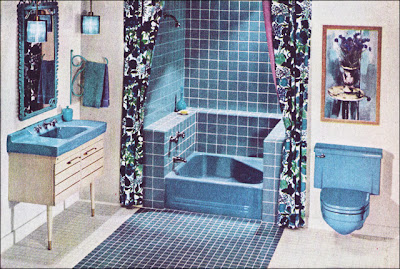 |
| LS3P Architects' Center City Green; Charlotte, NC. |
Coverings is on the hunt again for outstanding tile and stone projects where sustainability was a chief mission.
Installations judged worthy of recognition will earn a spot in Project: Green at Coverings 2011 in Las Vegas. Project: Green is a joint program with
Environmental Design + Construction magazine that's returning to Coverings in 2011. Projects selected for this distinction will enjoy exposure in a centerpiece display at the March 14-17th international trade show and conference at The Sands Expo and Convention Center in Las Vegas. An added benefit is subsequent feature in a 2011 issue of ED+C. Entries for Project: Green are now being accepted with submissions due by
Friday, January 14, 2011.
In 2010, Project: Green honored 12 entrants. They ranged from the USGBC’s own headquarters in Washington, DC; to a Whole Foods Market in Dedham, MA. Also among those recognized were a healthcare facility in Moderna Italy, and a residential project in British Columbia, Canada. In fact, Project: Green is open to both domestic and international projects. The key criteria are that they use tile and stone in a way that yields an aesthetically distinctive as well as environmentally responsible site, and qualify in one of the following categories: Residential New, Residential Remodel, Commercial New, Commercial Remodel, Institutional New, Institutional Remodel. Only projects completed between January 2009 and December 2010 will be considered.
The entry requirements include at least four photographic illustrations, along with two narrative essays. Essay #1 asks for detailed information on the tile and stone used in the project area, where it was applied and how much was installed; Essay #2 must describe how the project meets the judging criteria. There is no fee to enter, and it is open to architects, designers, builders, contractors, distributors, retailers, manufacturers and installers. Multiple entries are accepted.
You can find all of the information you need on the Coverings 2011 Website.
To better get into the spirit of things, here are some highlights from last year's Project: Green. Since this is a blog about residential design (usually), I'm going to show the top picks on the residential side.
First up is a
kitchen renovation by Harris Welker Architects in Rollingwood, Texas.
Why's it sustainable?
• Reutilization of existing space, no additional square footage added to kitchen area due
to large oak trees outside kitchen breakfast window
• Existing kitchen oak cabinets were deconstructed by Habitat for Humanity and resold/
reinstalled at another location; Cardell cabinets fabricated locally in San Antonio, TX
• Energy Star Kitchenaid appliances
• Vetrazzo recycled glass countertops
• T5 energy efficient cove lighting and LED undercounter lights
• Grohe Faucet and Kohler cast iron sink
• Sherwin WIlliams Harmony No-VOC paint
• Marazzi 13”x13” glazed porcelain floor tile
• Back-painted glass at cooking area backsplash; recycled glass “pool” tile
at wet area backsplash
• Waste management program
Next up is a new home in Winter Park, Florida.
The architect and builder is Phil Kean. Phil's a friend I've known for a longer than either of us want to admit and it's a thrill to see him honored like this.
Why's it sustainable?
• Stone walls are pre-consumer recycled quartz panels from RealStone Systems
• Driveway pavers cut from salvaged terrazzo flooring
• Sherwin-Williams Duration Home low VOC paint
• Gammapar bamboo flooring
• Stained concrete floors
• Shaw Green Label Carpet and Triple Touch Green Carpet Pad
• Locally manufactured custom veneer cabinets using low formaldehyde plywood and
water-based stains
• Alternate Energy Technologies solar water heating panels from AllSolar
• NCFI Sealite Polyurethane Spray Foam insulation — organic based
• 95% recycled-content drywall
• Hurd, Low-E, double pane, aluminum-clad wood windows
• Versico reflective roof membrane (minimal heat gain, recycled-content and Energy Star-
labeled)
• Carrier high-efficiency heat pump with 16.3 SEER
• Fresh-air intake; Infinity air purifier with a 15 MERV air filter; dehumidifier
• Dal-Tile ceramic and glass recycled-content tile
• Compact fluorescent lighting (CFLs) in 95% of lights
• Danze, Grohe & Hans Grohe high-efficiency plumbing fixtures
• Toto dual-flush toilets
• Thermador Energy Star appliances
• Bosch Axxis high-efficiency washer and dryer
• Drought-tolerant turf grass: Zoysia Grass
• EcoSmart fireplace
As if the house weren't enough, Phil won a separate award for the bathroom too. In addition to winning Best Bath for Project: Green, it was also named Orlando Bathroom of the Year in 2009. Bravo Phil!
Check out the rest of his projects on his website.
Why's it sustainable?
• Dal-Tile ceramic recycled-content tile
• Danze, Grohe & Hans Grohe water-conserving and high-efficiency plumbing fixtures
• Toto dual-flush toilets
• Granite-remnant vanity countertops
• Locally manufactured custom veneer cabinets by Frank Bennett of Longwood
• Low-formaldehyde plywood
• Low-VOC stains and finishes
• Sherwin-Williams Duration Home low-VOC paint
• Stained concrete floors
• Alternate Energy Technologies solar water heating panels from AllSolar
• NCFI Sealite Polyurethane Spray Foam insulation — organic based
• Concrete blocks salvaged from previous projects
• Exterior wall concrete block cells filled with concrete
• Concrete made of fly ash, a power plant by-product that increases durability
• 100% recycled-content drywall
• Boracare for termite control
• Hurd, Low-E, double pane, aluminum-clad wood windows
• Versico reflective roof membrane (minimal heat gain, recycled-content and Energy Star-
labeled)
• Carrier high-efficiency heat pump with 16.3 SEER and sized appropriately at 4 tons
(approximately 750 sf/ton)
• Fresh-air intake
• Infinity air purifier with a 15 MERV air filter
• Quiet and timed bath exhaust fans
• Dehumidifier
• Energy Star lighting package
• Compact fluorescent lighting (CFLs)
• Lutron sectional lighting control system
And finally, the best bath renovation from Project: Green 2010 wasn't designed and built by Phil Keane, it's by Sandra Khalil Interior Design in Surrey, British Columbia.
Why's it sustainable?
• Porcelain floor tile 23.5”x23.5”
• Glass wall tile 12”x22”
That may not sound like much but the tile used in that bathroom is is from Mirage in Italy. Mirage, like all Italian tile manufacturers, adhere to a standard of sustainability that's one of the most rigorous in the world.
This floor tile , Black Lines from their Fabric collection, proves that sustainability can be breathtaking.
So, if you're a designer or an architect with a sustainable project you're dying to show the world, Project: Green is your golden opportunity. It's open to entries from anywhere int he world and you can enter as many projects for consideration as you'd like.
Go to Coverings 2011's website for full details.




















































